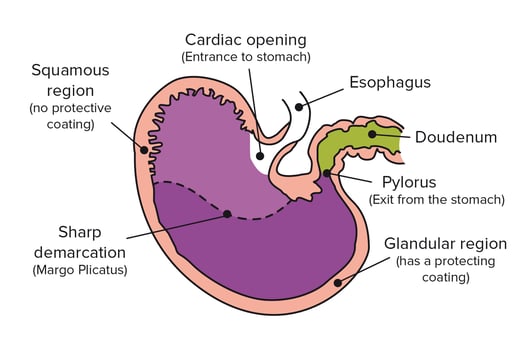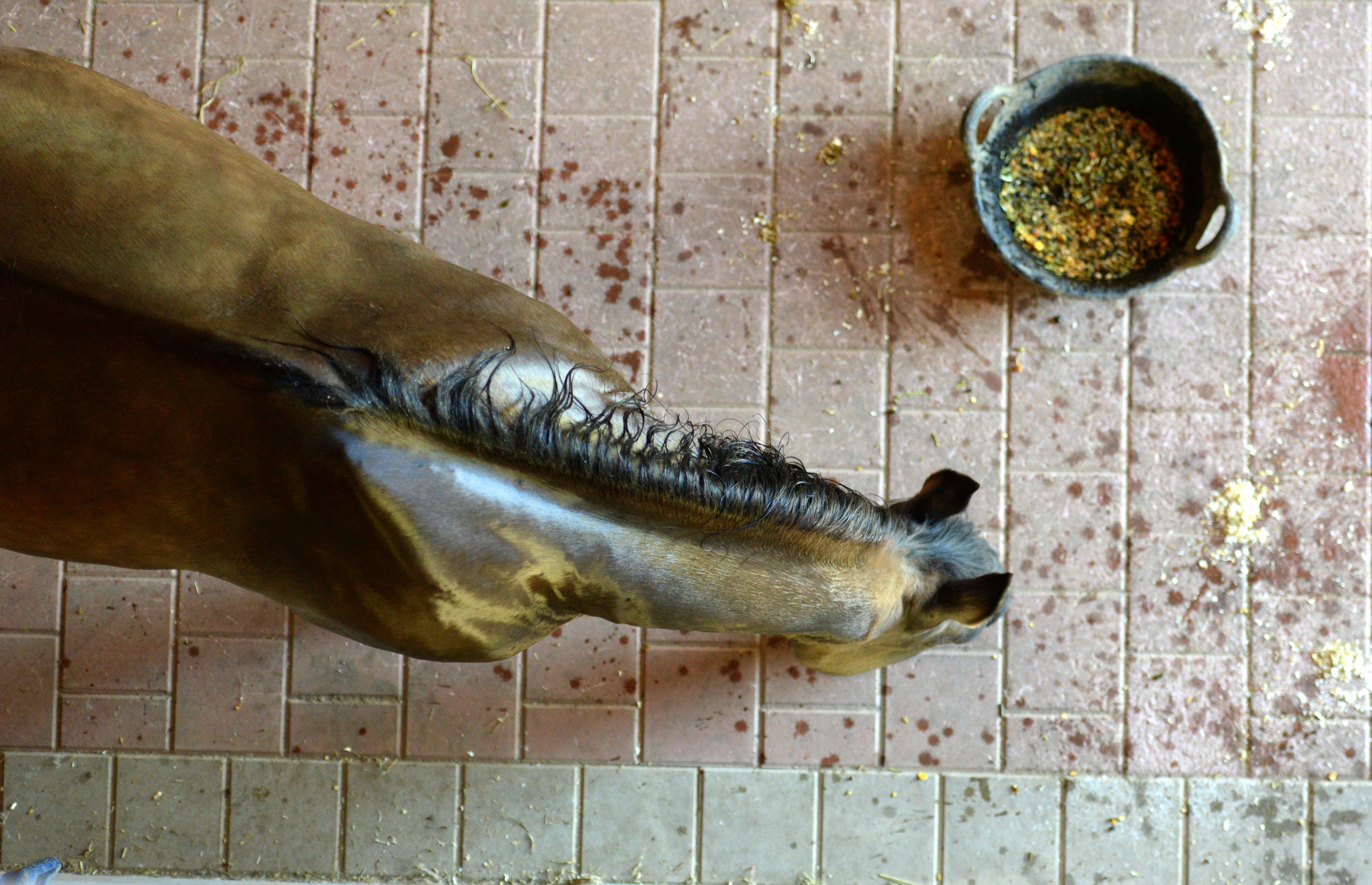Diagnosis: gastric ulcer in a horse
14 min. read time
Audio version – listen to this article easily
A glance at the literature shows that, depending on the group, 60-90 % of horses in human care will develop gastric ulcers during the course of their lives. So it’s quite likely that your horse will also have one sooner or later.
However, that’s no cause to throw in the towel, as there are quite a few measures one can take to keep them from occurring in the first place, or at least less often. Roughly speaking, there are two factors that play a major role in the development of equine gastric ulcers: stress and feeding.
Stress should be avoided where possible, of course, whilst some basic aspects of physiology should be considered when feeding. This article examines both of these aspects in detail.
Basically your horse’s stomach has a special feature: it produces gastric acid around the clock. Not only during or after consuming food, like humans, but continuously. For a horse that has constant access to grass or hay, this is good and necessary for aiding digestion.
It also means, however, that if a horse is not continuously eating, this stomach acid will simply slosh around in the empty stomach and attack the stomach lining, resulting in lesions and, ultimately, gastric ulcers. For horses in human care, this physiological peculiarity of their stomach can therefore be a problem and a challenge for their owners.
Regular access to feed will thus help protect the stomach lining and is therefore an important step in preventing gastric ulcers. There is another aspect that should not be forgotten: when a horse eats, it produces bicarbonate-containing saliva which then passes along with the feed to the stomach and buffers acid there. This point is important in selecting feed.

When feeding, we distinguish between high-fibre base feed/ roughage, which covers the horse’s need for feed structure, and low-fibre concentrate feed, which provides the horse with energy. It is important that feed be balanced in order not to overtax stomach physiology and metabolism. We base our calculation of the correct ratio of basic feed and perhaps also concentrated feed on a "model horse" with a weight of 500 kilogrammes.
Our model horse is healthy and gets an average amount of activity – neither constantly in the stable, nor worked particularly hard. Under these conditions, a hay content of 2 % of body mass, i.e. 10 kilogrammes per day, is recommended. Because gastric acid is produced continuously, part of the ration should constantly available during the night. Long intervals without feed will encourage excess acid formation in the horse's stomach.
If the horse eats too much concentrate feed, which passes quickly into the stomach, this can cause hyperacidity, as the horse will not have produced sufficient saliva to buffer the acid and additional acid will be produced through digesting the concentrate feed. To avoid this, it is important to feed the horse roughage first and then concentrate feed.

Another important factor when dealing with gastric ulcers: base feed and concentrate feed differ in structure and taste. Horses love to eat less-structured concentrate feeds, which they chew through less thoroughly and swallow more quickly than their base feed. This means that eating concentrate feed leads to the production of far less saliva (and less saliva in the stomach), and this will reduce its buffering effect.
In addition, concentrate feed absorbs acid in the stomach much less easily due to its smaller structure – and that’s bad news for the stomach’s mucous membranes. Consider, in contrast, high-fibre base feed, which requires much more thorough chewing. This in turn produces more saliva which adheres to the fibres and can then provide buffering effects in the stomach, whilst acid better penetrates the ingested base feed. This helps to protect the stomach.
Here you can read, what makes Equine 74 Gastric so special.
There are other factors to consider: whilst high-fibre feed is a good and necessary thing, the plant parts should not be too hard and prickly, because these can cause lesions to the stomach wall and thus lead to stomach ulcers. Lucerne chaff has a structure that is unsuitable for horses with stomach issues, even though it requires more chewing and thus helps to produce sufficient saliva.
Care should also be taken if, for example, there are oak trees in or near the horse’s pasture: acorns contain tannins which, when eaten by the horse, can lead to gastric ulcers.
One should also examine the quality of the feed. Always select a high-quality feed, because impurities, mycotoxins or misfermentation of hay all can have negative impacts on the entire gastrointestinal tract. It should also be mentioned here that haylage and silage are unsuitable for horses susceptible to stomach problems, as the acids they contain can irritate the stomach lining.
In addition to proper feeding, there is another important factor in the prevention of gastric ulcers: the avoidance of stress. With horses, stress always seems to hang over their heads by a thread.
These days, stress is used as a rather broad term, but it is ultimately reflected in the physiology of your horse. The body seeks a state of equilibrium. Stress is a disruptive factor that prevents the body from doing just that. Short periods of stress usually pose no problem as long as they are always followed by periods of relaxation.
If not, the horse's stomach reacts by producing a larger amount of gastric acid – that is, on top of what it is already producing continuously. This can lead to lesions in the stomach lining and gastric ulcers, which is why the avoidance of stress plays an important role in prevention.
.jpeg?width=3888&name=AdobeStock_45033982%20(2).jpeg)
Whilst the consequences of too much stress appear internally, their cause is mainly from external factors. Therefore, it’s necessary to take a closer look at relevant stressors.
Horses are basically creatures of habit and prefer having routines. Feeding, for example, is very important here. Yes, horses get hungry and need energy. What’s decisive is the time when the feed is provided. Your horse anticipates certain events to happen at certain times. He experiences expectation. If this is not met, horses may become competitive and aggressive amongst each other, because no horse wants to go without food.
In other words, it causes stress. A horse’s keeping can also be a problem if, for example, it is kept at close proximity to a horse it doesn’t get along with. The greatest stressor, of course, is a visit by the vet – only surpassed by a visit to the clinic, including transport, if the horse is not well. Now such visits are of course absolutely important and necessary for the health and well-being of your horse, but these events do not take place on a daily basis.
Good knowledge of the individual behaviour of your horse is not directly related to the prevention of stomach ulcers, but through careful observance you will be able to notice when your horse is stressed, i.e. when it behaves differently than it normally does.
As mentioned earlier, a single stressful situation won’t cause a stomach ulcer. Stressful situations that drag on over longer periods of time are much more problematic. These include, for example, problems in group dynamics, incompatible stable mates, being overworked or a stable alley with a lot of heavy traffic.
Always remember that horses have very good memories, and they will remember situations that previously caused them stress. Avoiding these or similar situations, and practising those situations which are unavoidable or which occur on a regular basis (for example being loaded in the trailer) can go a long way in sparing your horse’s stomach.
Equine 74 Gastric
Buffers the excess acid in the horse's stomach instead of blocking it.
Equine 74 Stomach Calm Relax
Supports the nervous horse stomach in stressful situations.